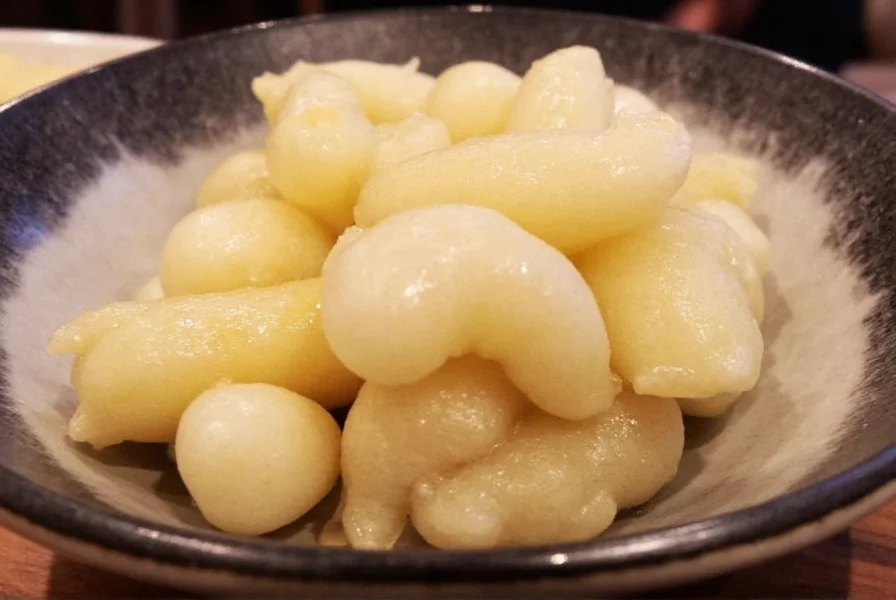
The Cultural Significance of Gari in Sushi Tradition
For centuries, gari has been an integral component of the Japanese sushi experience. Unlike regular pickled ginger used in other cuisines, authentic sushi ginger features young spring ginger that's naturally pale and tender. The traditional preparation method involves soaking thinly sliced ginger in a solution of rice vinegar, sugar, and salt, which creates its distinctive sweet-sour flavor profile and subtle pink hue—naturally occurring from the reaction between the ginger's enzymes and the vinegar.
Why Sushi Chefs Serve Pickled Ginger
Understanding the purpose of pickled ginger with sushi reveals thoughtful culinary design. Professional sushi chefs strategically place gari between different nigiri pieces for specific reasons:
| Function | Explanation |
|---|---|
| Palate Cleanser | Resets taste receptors between different fish varieties, allowing each sushi piece to be appreciated individually |
| Flavor Enhancer | The slight sweetness and acidity complement rather than overpower delicate fish flavors |
| Historical Food Safety | Ginger's natural antimicrobial properties provided protection against potential pathogens in raw fish |
| Digestive Aid | Traditional belief that ginger helps with digestion of raw seafood |
Proper Sushi Ginger Etiquette You Should Know
Many Western diners misunderstand how to properly consume pickled ginger with sushi. Authentic Japanese sushi etiquette specifies that gari should never be mixed directly with soy sauce or placed on top of sushi. Instead, eat a small piece of ginger by itself between different types of fish to cleanse your palate. This practice allows you to fully appreciate the nuanced flavors of each individual sushi piece without flavor crossover.
Authentic Gari Preparation vs. Western Adaptations
Traditional gari preparation differs significantly from what many outside Japan encounter. Authentic sushi ginger uses young spring ginger (shin-shoga) which naturally develops a pale pink color during pickling without artificial coloring. Many Western sushi restaurants use mature ginger that's artificially colored pink with beet juice or food coloring. The sugar-to-vinegar ratio also varies, with traditional Japanese preparation favoring a more delicate sweetness that doesn't overwhelm the ginger's natural flavor.
Health Benefits of Pickled Ginger in Sushi Culture
Beyond its culinary function, pickled ginger offers several health benefits that complement the sushi experience. Ginger contains gingerol, a bioactive compound with anti-inflammatory and antioxidant properties. The pickling process preserves many of these beneficial compounds while making them more bioavailable. When consumed with raw fish, gari's mild antimicrobial properties provide an additional layer of food safety, though modern refrigeration has reduced this necessity.
Common Misconceptions About Sushi Ginger
Several widespread misunderstandings exist about pickled ginger in sushi culture. Many believe the pink color comes from artificial dyes, when traditionally it develops naturally from young ginger's reaction with vinegar. Others think it should be eaten immediately before sushi, when proper etiquette specifies consuming it between different fish varieties. Some confuse gari with amazu shoga (red pickled ginger), which is stronger and used with richer dishes like tonkatsu rather than delicate sushi.
How to Identify Quality Pickled Ginger at Sushi Restaurants
Discerning quality gari involves several sensory indicators. Premium sushi ginger should have a translucent appearance with a natural pale pink gradient, not uniformly bright pink. It should feel tender but maintain slight crispness, never becoming mushy. The flavor profile should balance sweet, sour, and ginger notes without any single element dominating. High-end sushi establishments often prepare their gari in-house daily, while lower-quality venues may use pre-packaged versions with artificial ingredients.
Frequently Asked Questions
Why is pickled ginger pink with sushi?
Authentic sushi ginger (gari) develops a natural pale pink color from the reaction between young ginger's enzymes and vinegar during pickling. Many restaurants enhance this color with natural ingredients like umeboshi vinegar, though some lower-quality establishments use artificial coloring.
Can I make authentic sushi ginger at home?
Yes, authentic gari can be made at home using young ginger, rice vinegar, sugar, and salt. The key is using fresh spring ginger which naturally turns pink during pickling. Thinly slice the ginger, soak in vinegar-sugar solution for 2-3 weeks, and store refrigerated. Avoid artificial coloring for traditional results.
Is pickled ginger necessary for eating sushi?
While not strictly necessary, pickled ginger serves important culinary functions in the traditional sushi experience. It cleanses the palate between different fish varieties, allowing each to be appreciated individually. High-end sushi restaurants always include gari as part of the complete dining experience.
What's the difference between gari and regular pickled ginger?
Gari is specifically prepared for sushi with young ginger, a sweeter vinegar solution, and thinner slices. Regular pickled ginger (beni shoga) uses mature ginger, has a stronger flavor, and often appears brighter red. Gari's delicate flavor complements raw fish without overpowering it.
How should I store homemade pickled ginger?
Store homemade gari in an airtight glass container in the refrigerator. Properly prepared sushi ginger will keep for 2-3 months. Ensure the ginger remains fully submerged in the pickling liquid to maintain quality and prevent spoilage. The flavor continues to develop over the first few weeks.










 浙公网安备
33010002000092号
浙公网安备
33010002000092号 浙B2-20120091-4
浙B2-20120091-4